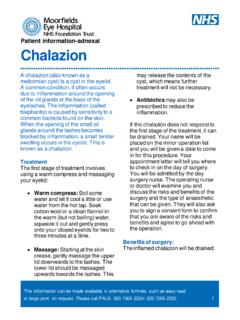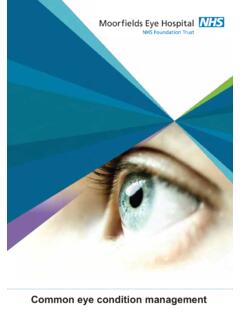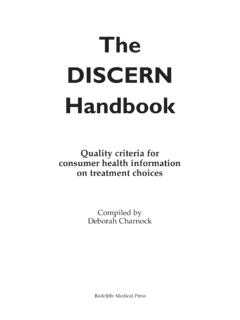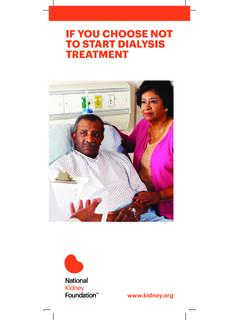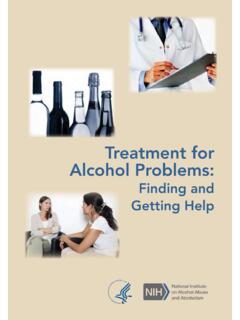Transcription of Patient information Anti-VEGF intravitreal injection treatment
1 Moorfields Eye Hospital NHS Foundation Trust City Road, London EC1V 2PD Phone: 020 7253 3411 Patient information Anti-VEGF intravitreal injection treatment This information sheet is written for patients who might undergo treatment with anti-angiogenic ( Anti-VEGF ) drugs. This treatment involves having an injection into your eye to treat certain retinal conditions that cause abnormal blood vessels to grow and leak under the retina. Patients with these conditions can lose central vision when abnormal blood vessels bleed or leak fluid under the retina at the back of the eye. A series of injections of Anti-VEGF medicines are given into the back of your eye to stop these blood vessels growing and help control the leakage.
2 This treatment is highly effective in preserving central vision in many people. In which common conditions might this occur? Wet age-related macular degeneration Myopic choroidal neovascularization Diabetic macular oedema Retinal vein occlusion Any other retinal conditions that causesfluid to leak under the retinaWhat is age-related macular degeneration (AMD)? Age-related macular degeneration (AMD) is the leading cause of vision loss in people aged 50 years or older. It involves damage to the part of the eye called the macula. The macula is a small, but extremely important area located at the centre of the retina, the light-sensing tissue that lines the back of the eye.
3 Moorfields Eye Hospital NHS Foundation Trust City Road, London EC1V 2PD Phone: 020 7253 3411 The macula is responsible for seeing fine details clearly. A person with AMD loses the ability to see fine details, both close-up and at a distance. This affects only the central vision. The side, or peripheral, vision usually remains normal. For example, when people with AMD look at a clock, they can see the clock s outline but cannot tell what time it is, or they will lose the ability to recognise people as shown. What is different about wet AMD? There are two types of AMD. Most people (about 75%) have a form called early or dry AMD, which develops when there is a waste build-up under the macula.
4 This state is compatible with normal or partially reduced vision. A minority of patients with early AMD can progress to the vision-threatening forms of AMD called late Sub-retinal bleeding at the macula in wet maculardegeneration Moorfields Eye Hospital NHS Foundation Trust City Road, London EC1V 2PD Phone: 020 7253 3411 AMD. The most common form of late AMD is exudative or wet AMD. Wet AMD occurs when abnormal blood vessels grow underneath the retina. These unhealthy vessels leak blood and fluid, which can prevent the retina from working properly. Severe damage leads to severe permanent loss of central vision, but the eye is not usually at risk of losing all vision (going 'blind') as the ability to see in the periphery remains.
5 There is a less common form of late AMD called geographic atrophy, where vision is lost through the macular tissue becoming completely worn out and there are no leaking blood vessels. Unfortunately, anti-angiogenic medicines cannot help this form of late AMD. What is myopic choroidal neovascularization? This condition occurs in people who are highly myopic (short-sighted). When someone is highly short-sighted, the retina at the back of the eye is stretched due to the increased size of the eye. This stretching can make the retina thinner and prone to splitting. When this occurs, blood vessels from the choroid (the layer of the eye behind the retina) can grow underneath the retina.
6 These new vessels (neovascularisation) leak blood and fluid, which can prevent the retina from working properly. Severe damage leads to severe permanent loss of central vision. What is Diabetic macular oedema (DMO)? Diabetic macular oedema is an eye condition occurring in people with both type 1 and type 2 diabetes. Macular oedema is swelling and thickening of the macula. The macula is a small area in the centre of the retina that contains a rich collection of nerve cells sensitive to light, fine detail, and colour. DMO occurs as a result of changes in retinal blood vessels in people with diabetes. Diabetes is characterised by increased levels of sugar (glucose) in the blood stream.
7 Consistently high blood sugar can damage blood vessels, with the first signs appearing in the smallest vessels, called capillaries. The damaged blood vessels will leak, causing the build-up of excess fluid (oedema) and blood in the macula. It can lead to severe impairment of central vision in the affected eye. What is Retinal Vein Occlusion (RVO)? RVO occurs when one of the retinal veins is blocked. The retina is the light sensitive tissue that lines the back of the eye and is responsible for the eyesight. RVO usually occurs when a retinal vein is: pinched off through the pressure of an artery lying on top of the vein; or is clogged with a blood clot or atherosclerotic plaque (fatty deposit in the wall of the artery); or is blocked by some inflammatory conditions.
8 The block Moorfields Eye Hospital NHS Foundation Trust City Road, London EC1V 2PD Phone: 020 7253 3411 can occur in the main retinal vein, central retinal vein occlusion (CRVO), or in one of the branches of the main vein, branch retinal vein occlusion (BRVO). Macular oedema is swelling and thickening of the macula. The macula is a small area in the centre of the retina that contains a rich collection of nerve cells sensitive to light, fine detail, and colour. The vein block causes the blood pressure to increase in the small retinal blood vessels which causes them to bleed and leak fluid into the retina forming a macular oedema and the retina may also be affected by poor blood flow and inflammation.
9 All these processes lead to decrease/loss of vision in the affected eye. Pregnancy and breast-feeding? If you are pregnant or planning to become pregnant, please discuss this with your doctor before your intravitreal injection treatment . Anti-VEGF medicines should not be used during pregnancy. Women of child-bearing potential should use effective contraception during their treatment and for at least three months after the last intravitreal injection . If you do become pregnant whilst undergoing intravitreal injections please inform your doctor immediately. Anti-VEGF medicines are not recommended during breast-feeding because it is not known whether the medicine passes into human milk.
10 Ask your doctor for advice before treatment . How does an injection of these Anti-VEGF medicines prevent visual loss? Anti-VEGF medicines stop the abnormal blood vessels growing then leaking and bleeding under the retina. This prevents or limits damage to the retinal light receptors and loss of central vision. These medicines are effective in preventing further central vision loss in up to 90% of treated eyes. Is Anti-VEGF treatment right for you? Your ophthalmologist will advise if the treatment is appropriate for you and which Anti-VEGF will be used. Only patients with active leaking of blood and fluid can benefit from it. The treatment that s right for you will depend on the specific condition of your central retina (macula), your vision and whether there is scarring at the macula.
